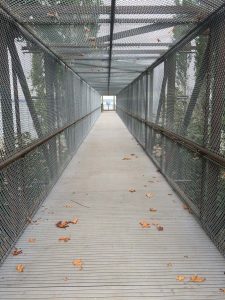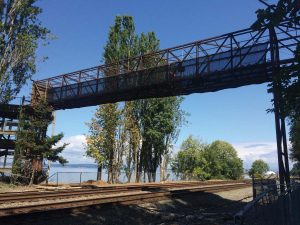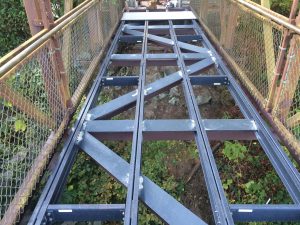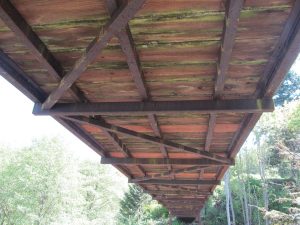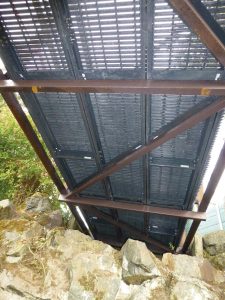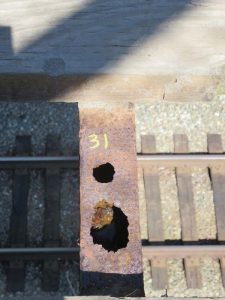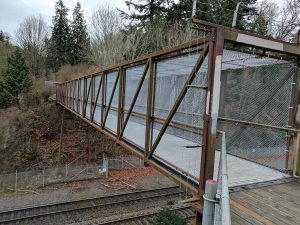Saving the Path to the Beach
Perched on a bluff along the shore of Puget Sound, Howarth Park is a heavily wooded and frequently used public park in Everett, Washington. With its spectacular views of the Sound and small beach at the water’s edge, the park is very popular. However, like most of the eastern shore of Puget Sound north of Seattle, the actual beachfront is cut off from the uplands by the Burlington Northern Santa Fe (BNSF) railroad line. The public must cross a pedestrian bridge over the railroad tracks and descend down to the beach level on a wooden stair tower to access the beach.
The Existing Bridge
The existing pedestrian bridge is a nine-foot tall, eight-foot wide, two-span steel box truss structure that spans 49 feet from the hillside abutment to its center steel support tower, and then 80 feet across the BNSF tracks. This bridge, built in 1987 to replace an earlier timber bridge, was constructed entirely of weathering steel tubular sections. It was designed and built by a large national bridge design-build firm and was constructed economically, with small, thin-walled hollow structural sections (HSS). Many of the HSS truss members were 1⁄8- or 3⁄16-thick. It is likely that weathering steel was chosen for its natural weather protection and low maintenance attributes.
Weathering Steel
Weathering steel is often referred to by the trade name of Cor-Ten, or Corten as originally produced by the US Steel Corp. It is available in various ASTM standards, including A588 and A847 (for pipe and tubes shapes), and has a special chemical makeup that causes the surface to develop a protective oxide patina that can reduce or eliminate the need for a protective coating. Initially, this patina develops similarly to corrosion of normal carbon steel. However, once the patina stabilizes, it forms a dense barrier between the base metal and the external elements. Some additional corrosion continues over the life of the structure but at a very slow rate. Thus, the patina protects the steel from the atmosphere. The successful use of weathering steel depends on several factors, but key among them is one crucial design concept – the steel must be allowed to dry fully between wettings. If the steel is used in conditions that cause it to stay wet for long periods of time, the oxidation process continues beyond the protective patina stage, and detrimental corrosion will develop.
About the time that this bridge was built, weathering steel was very popular for bridges and other structures throughout the country. However, some issues were starting to come to light and, in 1989, the Federal Highway Administration (FHWA) published a Technical Advisory, Uncoated Weathering Steel in Structures, which presented guidelines for the proper use of weathering steel. This document outlines several situations in which weathering steel is not recommended. Unfortunately, several of these situations could exactly describe the Howarth Park pedestrian bridge. FHWA guidelines include: 1) weathering steel should not be used where the atmosphere is wet for long periods of time; 2), weathering steel should not be used in a marine environment; and 3) weathering steel should not be used where site conditions don’t allow rapid drying, or where detailing may cause trapping of water on the steel surface. All of these conditions exist at the site of this structure, located on a bluff overlooking the Puget Sound.
The Existing Conditions
The owner was concerned about the condition of the bridge, as some excessive corrosion of the truss members had been observed near the hillside abutment. That end of the bridge is shielded from the drying action of the wind by surrounding trees and vegetation as well as the abutment itself. KPFF was requested to perform an assessment of the integrity of the existing bridge. It was decided that a survey of remaining steel thickness should be conducted on representative members throughout the structure. This was based on visual observation of the members and the knowledge that the original thickness of the steel members was thin. Mayes Testing Engineers conducted ultrasonic testing of the HSS section thicknesses of selected members of all parts of the bridge structure.
The primary members of the box truss – the chords, diagonals, and cross beams – all were found to have minimal loss of section. The protective patina seemed to be performing as intended. The walking surface of the bridge consisted of 3×12 timbers laid across three HSS 4x3x1⁄8-inch longitudinal stringers, which in turn rested on HSS 5x3x3⁄16 cross beams at the truss bottom chord panel points. When some of the timbers were removed to test the HSS stringer members, it was discovered that many had corroded so badly that large holes were present on the top faces. This was the result of a design detail that allowed the wood members to prohibit drying of the steel surface. Also, the timbers were bolted to the stringers with bolts tapped into the steel tubes. This allowed water to make its way into the tubes, corroding them from the inside. In addition, there was a lot of sand trapped in the joints between the timber walking surface members. The foot traffic from the beach delivered a continuous supply of chloride-laden beach sand to the steel surface. As a result of this discovery, the bridge was immediately closed to the public and a design commenced to replace the degraded members.
Repair Design
Several types of decking were investigated as options to replace the timbers, and it was determined that Fiberglass Reinforced Plastic (FRP) T-bar pultruded grating would provide the best alternative as it is weather resistant, non-corroding, and light-weight. The open cross-section allows unrestricted air flow to the steel truss members. Initially, the repair design intended to replace the corroded stringers with new weathering steel HSS sections. During discussions with the FRP grating supplier, Fibergrate Composite Structures, it became apparent that a better long-term solution would be to use FRP structural members for the stringers. The three HSS 4×3 deck stringers were replaced with four stringers of 6-inch by 3⁄8-inch double FRP C-shapes, also provided by Fibergrate. New weathering steel tabs were welded to the tops of the existing cross beams and the FRP C’s were bolted to these.
The only members of the existing primary steel box truss that were replaced with new weathering steel were a few lower chord diagonals and cross beams near the abutment end of the pedestrian bridge. These members, as well as strategic portions of the existing steel structure where there was a possibility of continuous wet conditions, were coated with a high-performance paint system. In keeping with current common practice, the overall approach was to paint weathering steel in portions of the bridge where excessive moisture or inadequate air flow was likely.
The chosen FRP decking has a T section with small spaces at the walking surface. This shape is often used near pools and other places where people walk barefoot. It was chosen for the Howarth Park project to minimize the possibility of pedestrians dropping small items through the cracks onto the active railroad lines below. Also, to minimize the buildup of sand on the remaining steel cross beams and diagonals below the deck, flat sheets of ¼-inch FRP were installed above those members as sloped “sand shields” to shed the sand that falls through the grating.
Another benefit of using FRP members to replace existing members is that FRP is lightweight, an important factor for an existing structure with little reserve capacity. The repair approach decreased the weight imposed on the structure, as well as the seismic mass.
Design that Addresses Construction Constraints
An additional consideration in choosing light weight FRP members to replace existing ones is that the Howarth Park pedestrian bridge is in a remote location, with limited access. The remote site meant that the contractor, Forma Construction, was required to hand-carry all construction materials and equipment to the site. Very little field welding was required in the new design, and the FRP members were connected with stainless steel bolts or self-tapping screws. The sand shields were connected with stainless steel gauge metal clips normally used for wood construction. The entire project was accomplished with hand tools.
The FRP supplier produced shop drawings for the members, similar to steel fabrication drawings. Once construction started, the process went smoothly. The biggest challenge on the project turned out to be the lengthy process of getting approvals from the railroad to work over a highly trafficked, active railway.
Conclusion
Over the course of its 30 years, a majority of the Howarth Park pedestrian bridge weathering steel members performed as intended with regard to corrosion, despite being located in a marine environment. Only where detailing or natural shielding of the bridge prevented adequate drying of the steel did the steel corrosion continue to a dangerous state. With weathering steel, proper design and detailing to allow air circulation and thus drying cycles is essential. The choice to replace some weathering steel members with FRP members allowed for efficient design and construction. Typically, FRP is used in caustic environments such as chemical plants or proximity to salt water, but the use of FRP structural members for this pedestrian bridge repair enabled the work to be completed efficiently with corrosion-resistant materials. The bridge is now re-opened to the public and will provide many years of additional service.▪
Project Team
Owner: City of Everett Parks and Recreation
Structural Engineer: KPFF Consulting Engineers, Seattle, WA
Testing Agency: Mayes Testing Engineers, Inc., a Terracon Company, Lynnwood, WA
Contractor: Forma Construction, Olympia and Seattle, WA
FRP Structural Sections: Fibergrate Composite Structures

